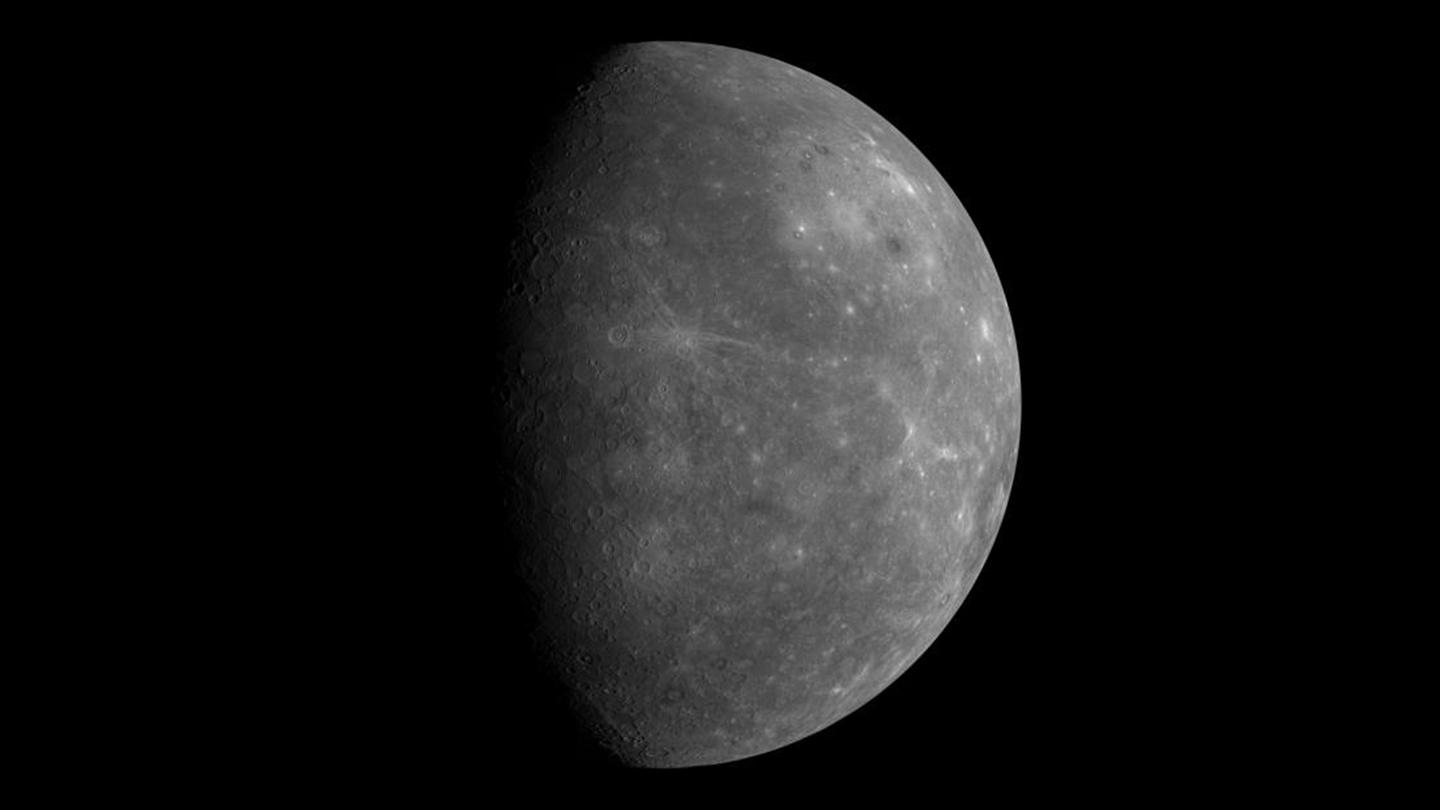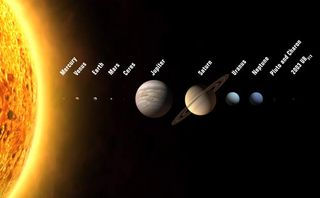How Big is Mercury?

Mercury is the smallest planet in the solar system. (Pluto used to hold the title, but it was downgraded to a dwarf planet.) Although its surface resembles our moon, the tiny planet has a density that rivals Earth itself.
Radius, diameter and circumference
Mercury's diameter is 3,030 miles (4,878 km), comparable to the size of the continental United States. This makes it about two-fifths the size of Earth. It is smaller than Jupiter's moon Ganymede and Saturn's moon Titan.
But it's not going to stay that size; the tiny planet is shrinking. When NASA's Mariner 10 spacecraft visited the planet in the 1970s, it identified unusual features known as scarps that suggest the world is shriveling. As the hot interior of the planet cools, the surface draws together. Since the planet boasts only a single rocky layer, rather than the myriad tectonic plates found on Earth, it pushes on itself to create scarps.
A 2014 study of nearly 6,000 scarps taken by NASA's MESSENGER spacecraft suggest that Mercury contracted radially as much as 4.4 miles (7 kilometers) since its birth 4.5 billion years ago. The discovery helped balance models of the planet's interior evolution with observations at its surface.
"These new results resolved a decades-old paradox between thermal history models and estimates of Mercury's contraction," Paul Byrne, a planetary geologist and MESSENGER visiting investigator at Carnegie's Department of Terrestrial Magnetism, said in a statement. "Now the history of heat production and loss and global contraction are consistent."
The planet has a mean radius of 1,516 miles (2,440 km), and its circumference at the equator is 9,525 miles (15,329 km). Some planets, such as Earth, bulge slightly at the equator due to their rapid rotation. However, Mercury turns so slowly on its axis that astronomers once thought that the planet was tidally locked, with one side constantly facing the nearby sun. In fact, the planet spins on its axis once every 58.65 Earth days. Mercury orbits once every 87.97 Earth days, so it rotates only three times every two Mercury years. The slow spin keeps the planet's radius at the poles and the equator equal.
Density, mass and volume
Mercury has a mass of 3.3 x 1023kilograms. This mass is contained in a volume of 14.6 billion cubic miles (60.8 billion cubic km). The mass and volume of Mercury is only about 0.055 times that of Earth.
But because Mercury's small mass is enclosed inside of a tiny body, the planet is the second densest in the solar system, weighing in at 5.427 grams per cubic centimeter, or 98 percent of the density of our planet. Only Earth is denser. This high density in a planet that otherwise resembles the moon raises interesting questions about the composition of the planet's interior.
Mercury's small size makes it too weak to hold onto a significant atmosphere, especially with the constant bombardment it receives from the sun. The planet has a thin atmosphere, but it is constantly blasted into space by the solar wind. Without an atmosphere to help stabilize the incoming heat from the sun, the planet boasts some of the most varying temperature swings in the solar system.

Surface features
Mercury's surface greatly resembles that of Earth's moon, with craters left over from the heavy bombardment early in the life of the solar system and during the planet's formation. Images taken by the Mariner 10 spacecraft show craters ranging from 328 feet (100 m) to 808 miles (1,300 km) across. Several of the planet's scarps reach as high as 1.86 miles (3 km).
Mercury also boasts hollows—shallow, irregular depressions that seem unique to the planet. Hollows are some of the youngest and brightest features on the surface of Mercury, and range in size from 60 feet to over a mile across and 60 to 120 feet deep. With no atmosphere, the hollows weren't carved by wind or rain. Instead, they may be caused by volatile minerals evaporating after suddenly being exposed by an impact.
"These hollows were a major surprise," David Blewett, science team member from the Johns Hopkins University Applied Physics Laboratory, said in a statement. "We've been thinking of Mercury as a relic – a place that's really not changing much anymore, except by impact cratering. But the hollows appear to be younger than the craters in which they are found, and that means Mercury's surface is still evolving in a surprising way."
Ironically, the planet closest to the sun contains ice on its surface. (It's not the hottest planet; that honor is reserved for Venus.) The northern and southern poles lie in constant shadows, allowing ice to build up on their floor. Radar-bright deposits were spotted from Earth, and MESSENGER confirmed these regions lie in constant shadows. Eventually, the spacecraft was able peer directly into the craters and confirm that water ice is stable inside them.
"For more than 20 years the jury has been deliberating on whether the planet closest to the Sun hosts abundant water ice in its permanently shadowed polar regions," MESSENGER's primary investigator Sean Solomon, of Columbia University in New York, said in a statement.
"MESSENGER has now supplied a unanimous affirmative verdict."
Editor's Note: This article was updated on Dec. 12, 2018 to reflect a correction. The original article stated that Mercury's volume is 14.6 trillion cubic miles.
Join our Space Forums to keep talking space on the latest missions, night sky and more! And if you have a news tip, correction or comment, let us know at: community@space.com.
Get the Space.com Newsletter
Breaking space news, the latest updates on rocket launches, skywatching events and more!

Nola Taylor Tillman is a contributing writer for Space.com. She loves all things space and astronomy-related, and enjoys the opportunity to learn more. She has a Bachelor’s degree in English and Astrophysics from Agnes Scott college and served as an intern at Sky & Telescope magazine. In her free time, she homeschools her four children. Follow her on Twitter at @NolaTRedd